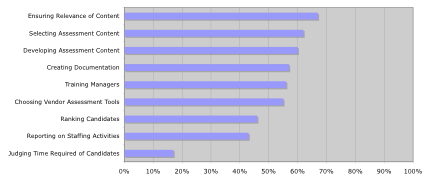Article and research by Charles Handler and Mark C. Healy
For the last seven years, Rocket-Hire has surveyed users of web-based pre-employment assessment tools, so we again asked members of the ERE community to tell us about their usage of typical pre-employment screening, testing, and assessment programs. As with years past, we zeroed in on the pulse of pre-employment assessment usage. And in an increasing climate of legal scrutiny for testing, and the hoopla surrounding the Ricci case, we decided to focus the content of today’s article on two issues that are inexorably linked: Implications of evaluating one’s assessment strategy, and attention to relevant legal issues.
Those interested in obtaining a copy of our full report can email us (chandler@rocket-hire.com) and we will be sure to send you a full copy once it has been completed.Or, check out an upcoming Journal of Corporate Recruiting Leadership, probably the October 2009 issue, where we’ll have an in-depth analysis.
A Word About our Methodology
This year, 148 recruitment and hiring professionals completed the Rocket-Hire Online Assessment Usage Survey. Respondents were evenly representative of recruiters, recruiting leaders, HR executives, business owners, and hiring managers, and featured a wide variety of organizations and hiring situations.
Use of Assessment Tools
Overall usage of assessment tools was generally about the same as in past years — roughly two-thirds of respondents. Of that two-thirds, 54% are deploying both paper-based and online assessment, and 30% are using exclusively online assessment. The remaining employ only paper-based tools. Most use a variety of different assessment methods, with the majority using between one and three different types. The table below reveals the proportion of firms using various common tools.
Usage rates of common assessment tools

Skills and knowledge certifications and personality assessments continue to be popular, with indicators of cultural “fit” and various cognitive ability measures also widely used. In addition, we observed a surge in the adoption of web-based background investigation strategies.
Interestingly, 2009 highlights a trend emerging over the last few years: It is now just as common to find organizations deploying assessment company-wide as it is to find it used for only one or two jobs. These findings reflect the fragmented use of assessment that we have experienced in our client work. To be sure, there are tons of ways assessment can be used, but there is no one major trend in how or how much it is implemented.
Effectiveness of Screening and Assessment Tools
This year, 80% of assessment users felt that assessment had a “positive impact” on their organization. In contrast, only 3% of assessment users felt these tools did not add value. However, only 64% of assessment users collected metrics to judge the quality of their interventions, and 79% judged ROI using one or many indicators. However, definitions of “ROI” vary widely, with some approaches considering a broad, cursory opinion from managers, whereas only a few use a true scientifically derived method such as a validation study.
Wide variation in the real-world evaluation of ROI clearly reveals that, while many companies do collect metrics, few of them are going about this in a way that reflects best practices. This is cause for concern given the fact that these same best practices create the foundation for demonstrating the legal defensibility of assessment measures.
Legal Issues
This year’s Supreme Court decision in favor of firefighters who challenged the City of New Haven, Connecticut, has once again focused attention on the legal aspects of pre-employment assessment. In anticipation of the High Court hearing this case, we wondered how much typical users paid attention to legal and regulatory issues related to using assessment to evaluate candidates.
Percent indicating legal issues are “central to this activity” or “very prominent”

These results express both positive and negative connotations. On the positive side, it seems that a good number of companies pay attention to legal issues related to testing and assessment. On the other hand, perhaps more firms should consider devoting resources to demonstrating and documenting legal defensibility. The lack of understanding of what is actually required for ensuring compliance and defensibility may create problems as both assessment usage and legal scrutiny increase.
The energy spent on legal considerations does not relate to the extent of assessment deployed, or size of the organization, nor number of hires. As with overall usage of assessments, legal concerns do not follow any pattern across survey respondent demographics or assessment strategies.
Legal defensibility is not just another set of meaningless hoops that must be jumped through and checked off. Proper evaluation of ROI via validation and legal defensibility are actually two sides of the same coin, the common goal being to document the job-relatedness of all tools and processes used to select employees.
Though the continued economic turmoil has put a damper on hiring, the adoption of in-depth assessment tools continues to grow, especially as more organizations devote resources to find out if testing and assessment is worth it. The bottom line: Quality hiring tools can improve performance and employee engagement (i.e., provide ROI) while also ensuring the legal defensibility of hiring practices, but it is essential to demonstrate how much they actually benefit your organization.